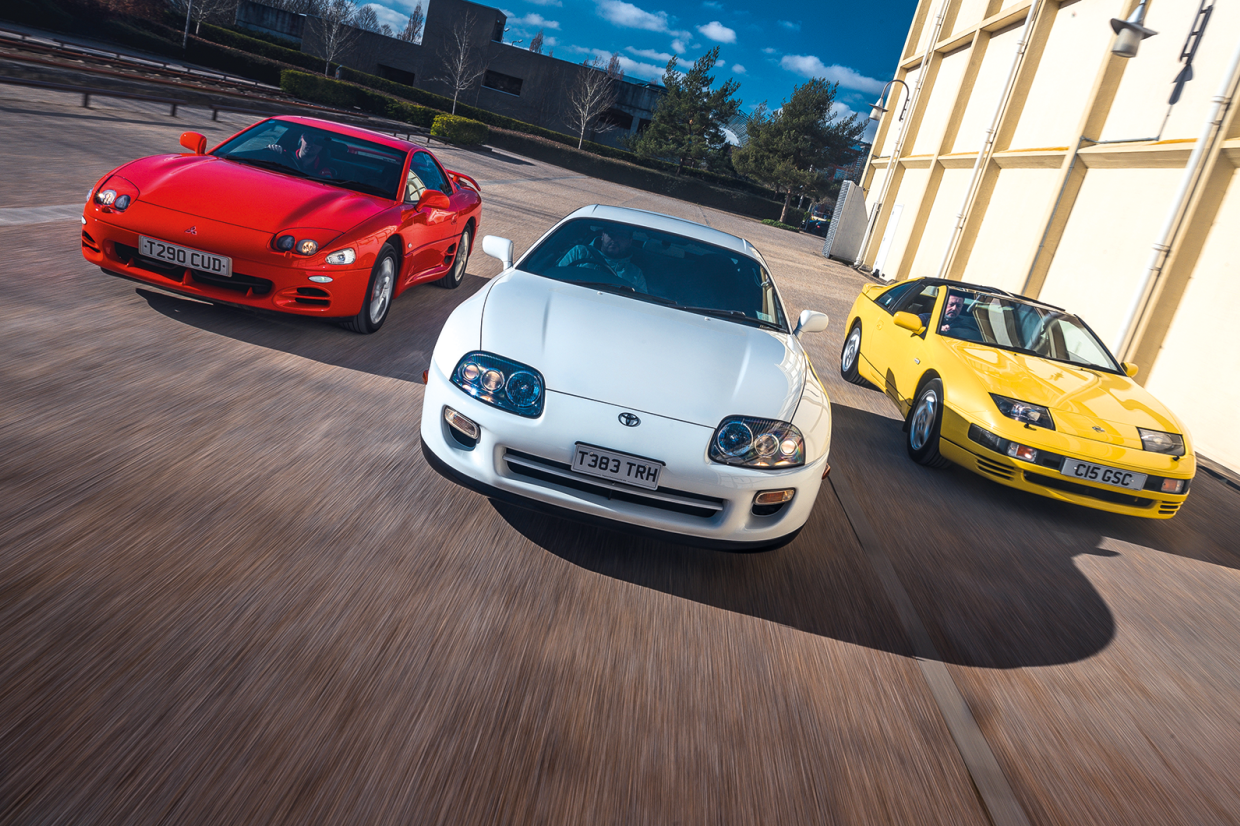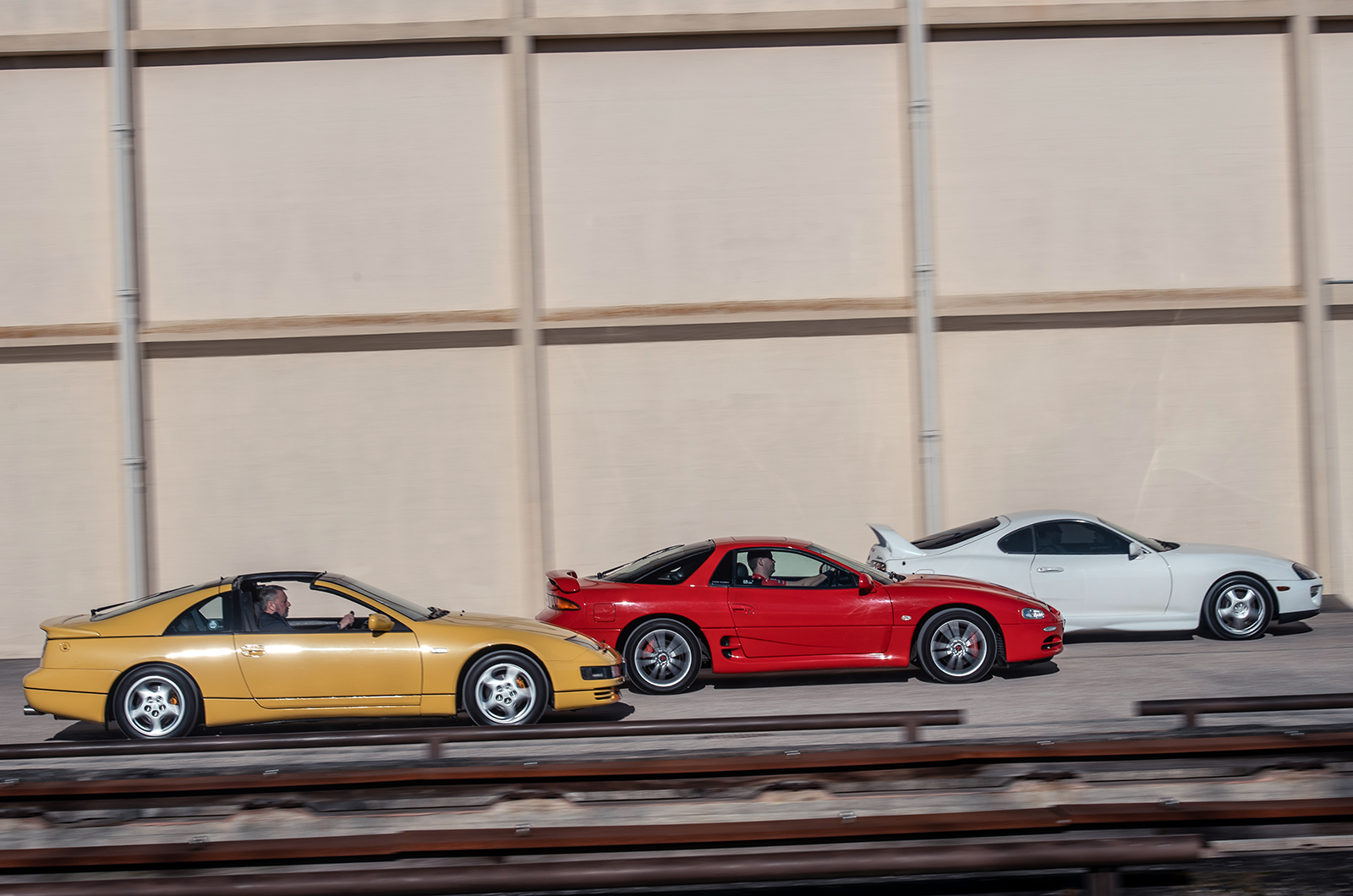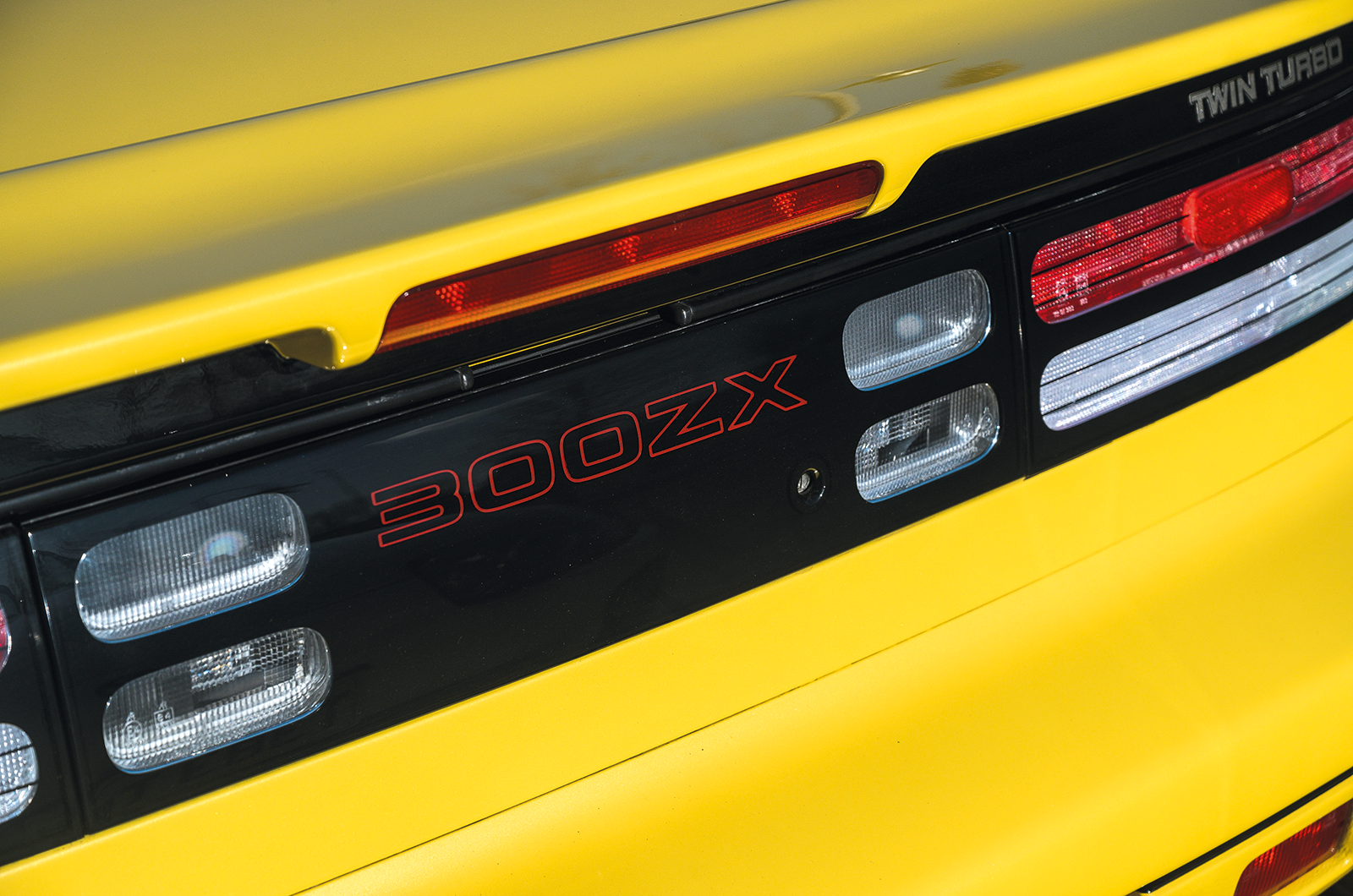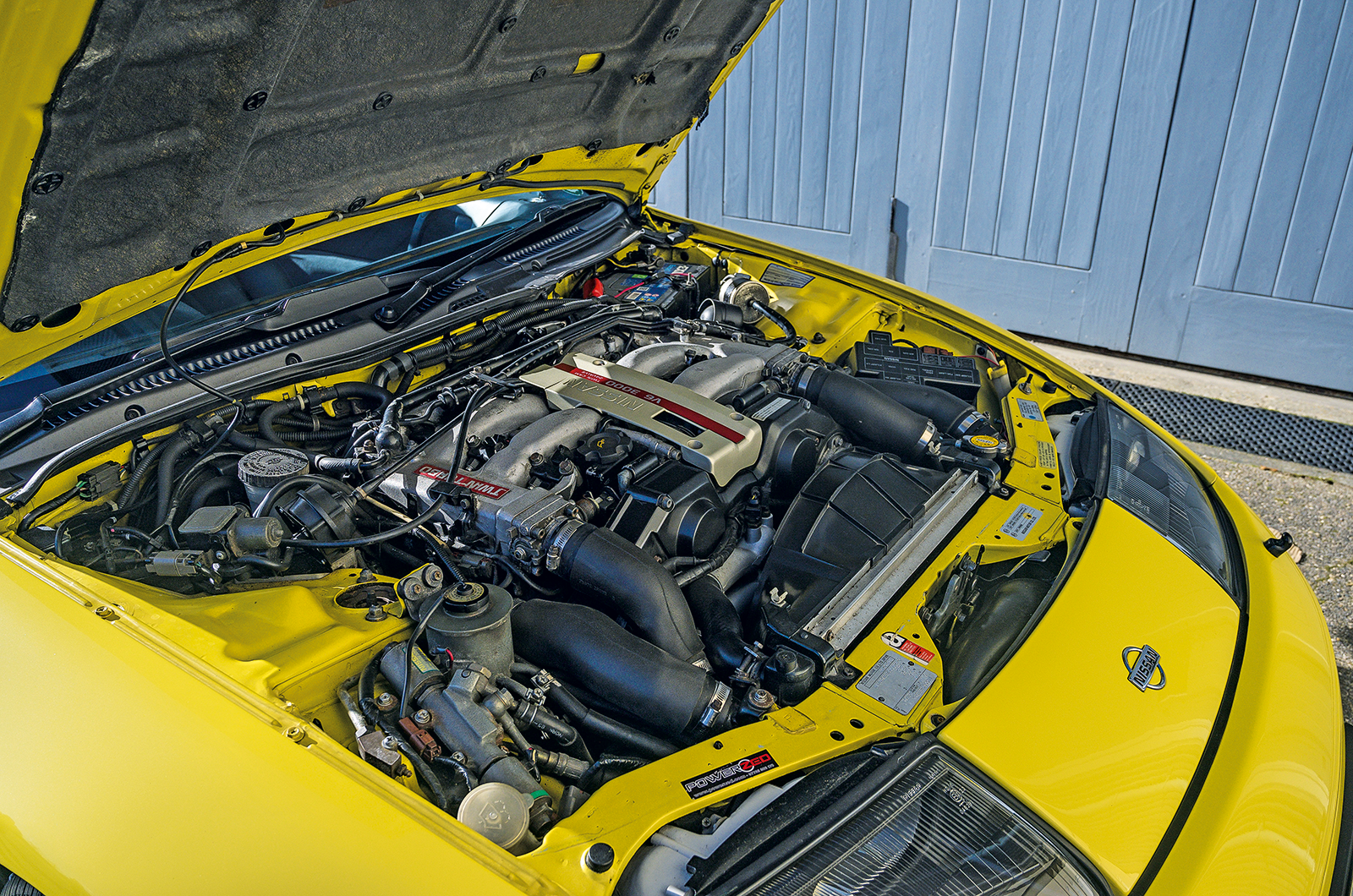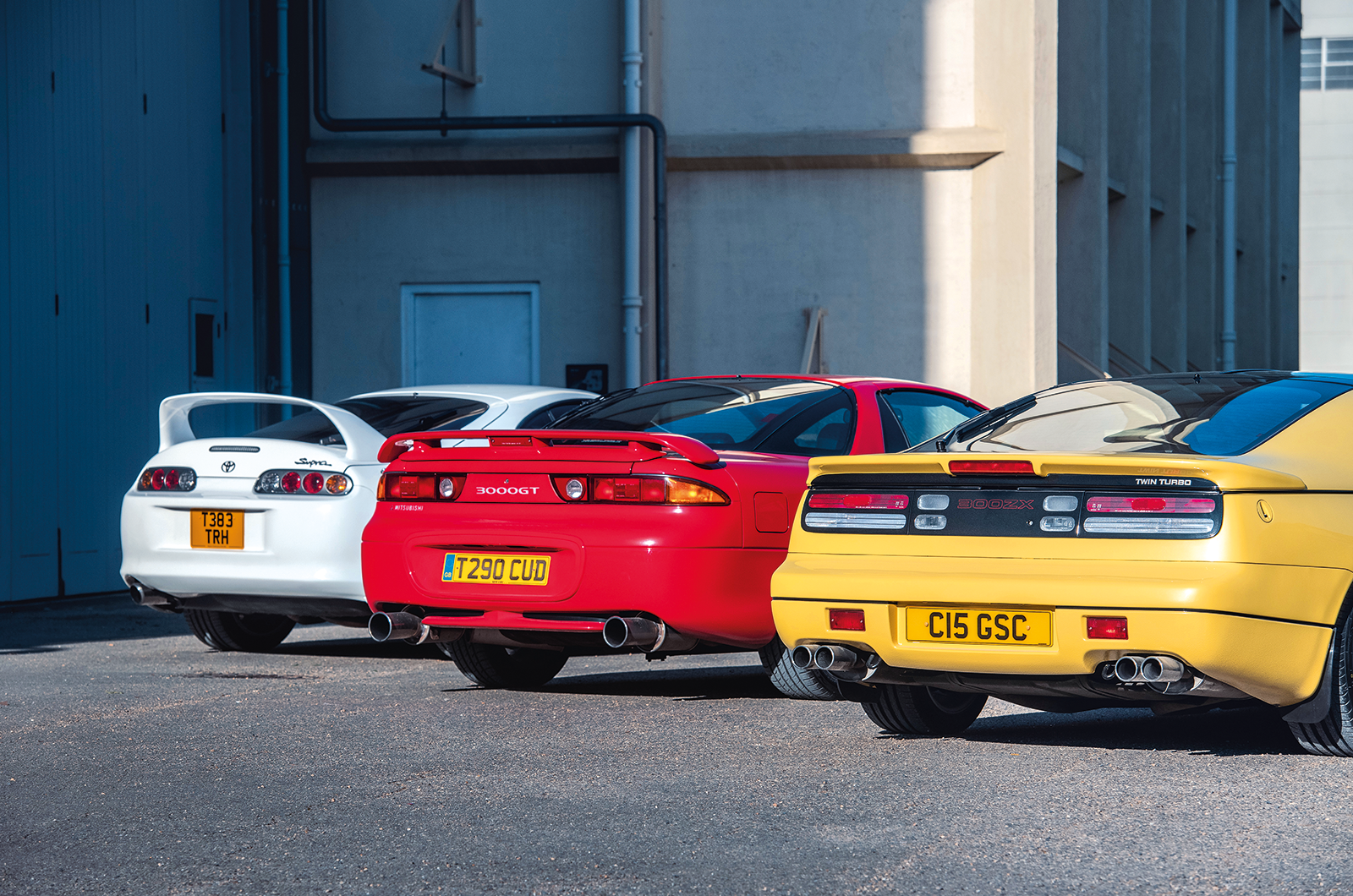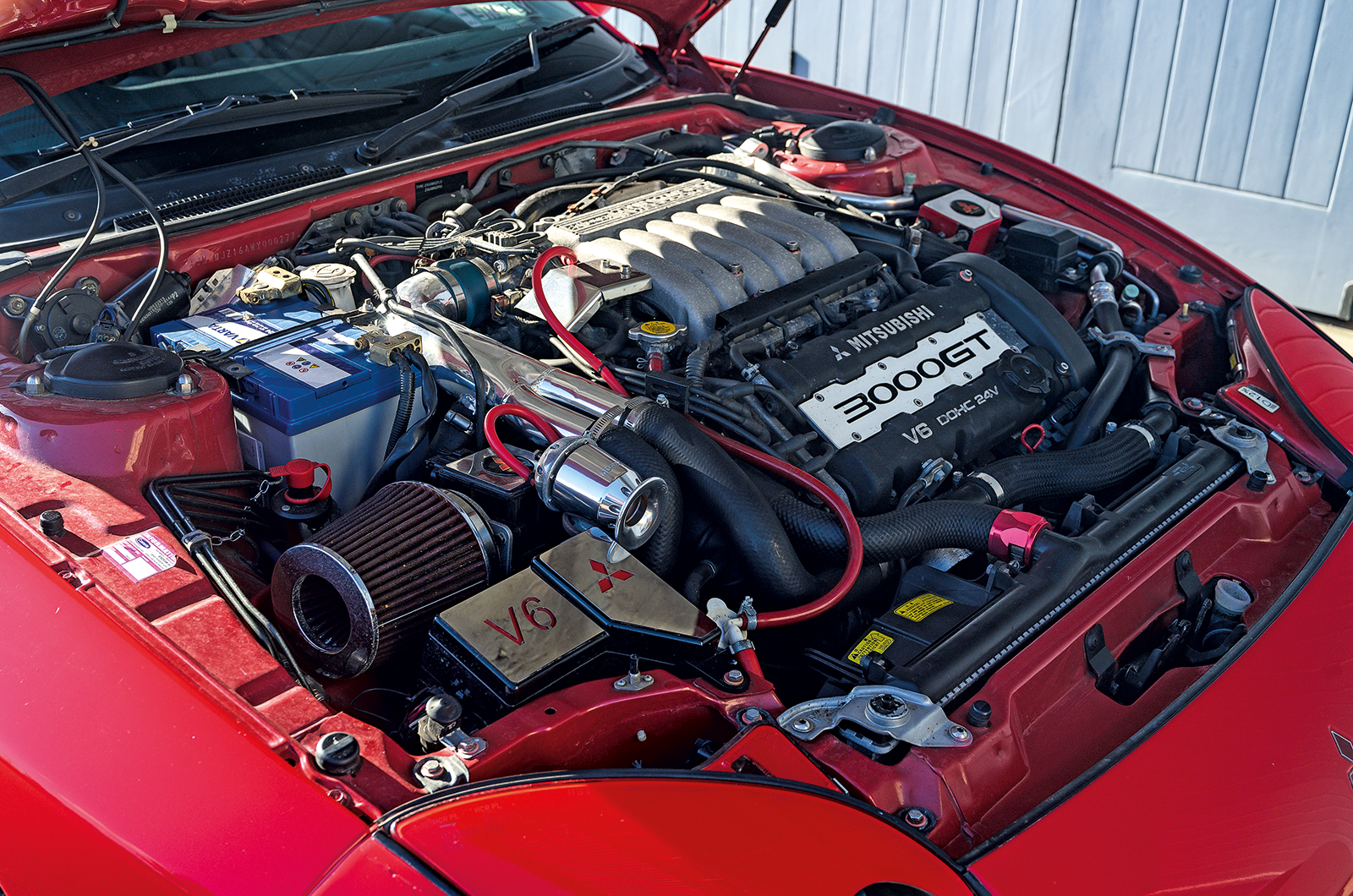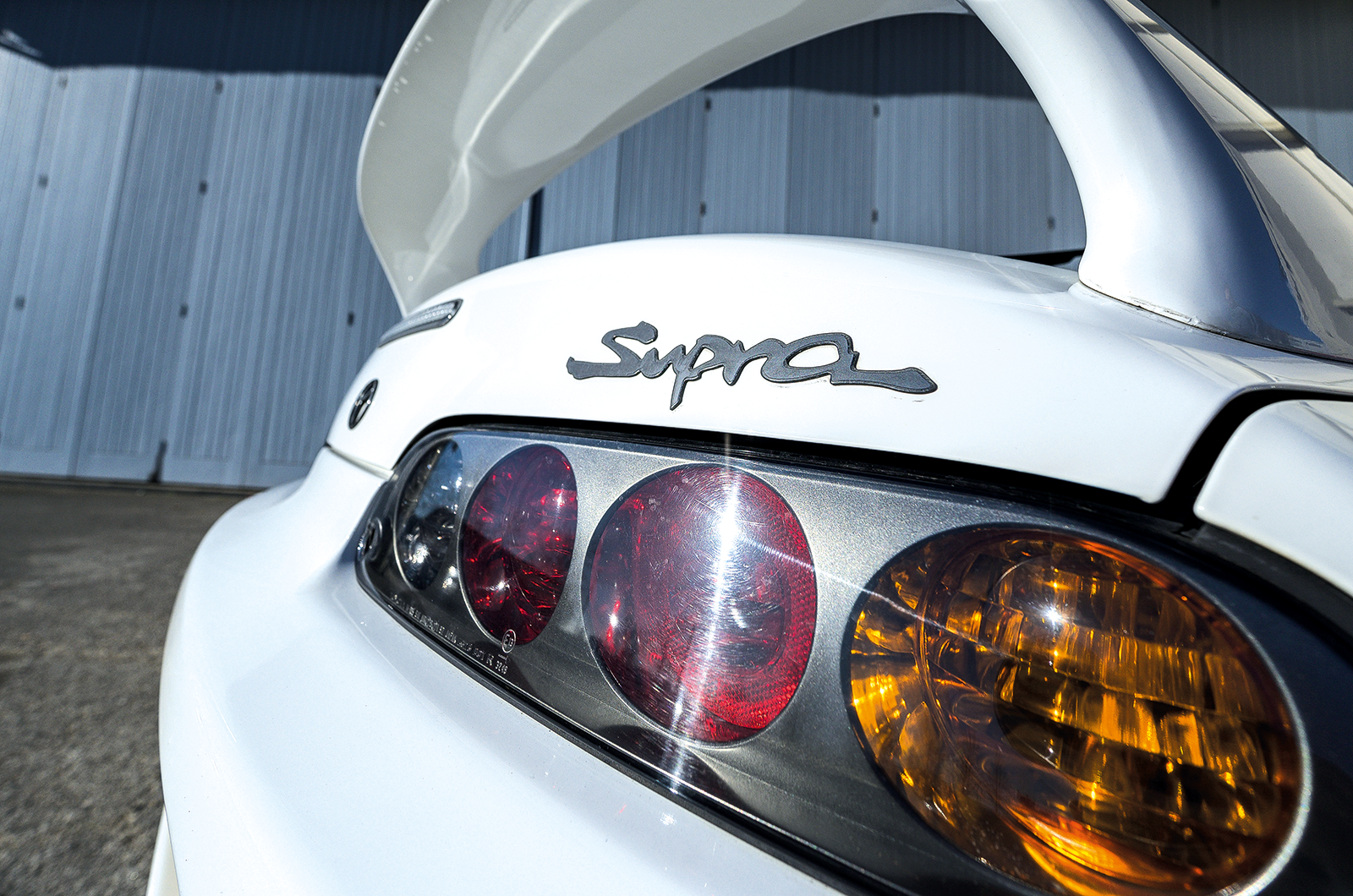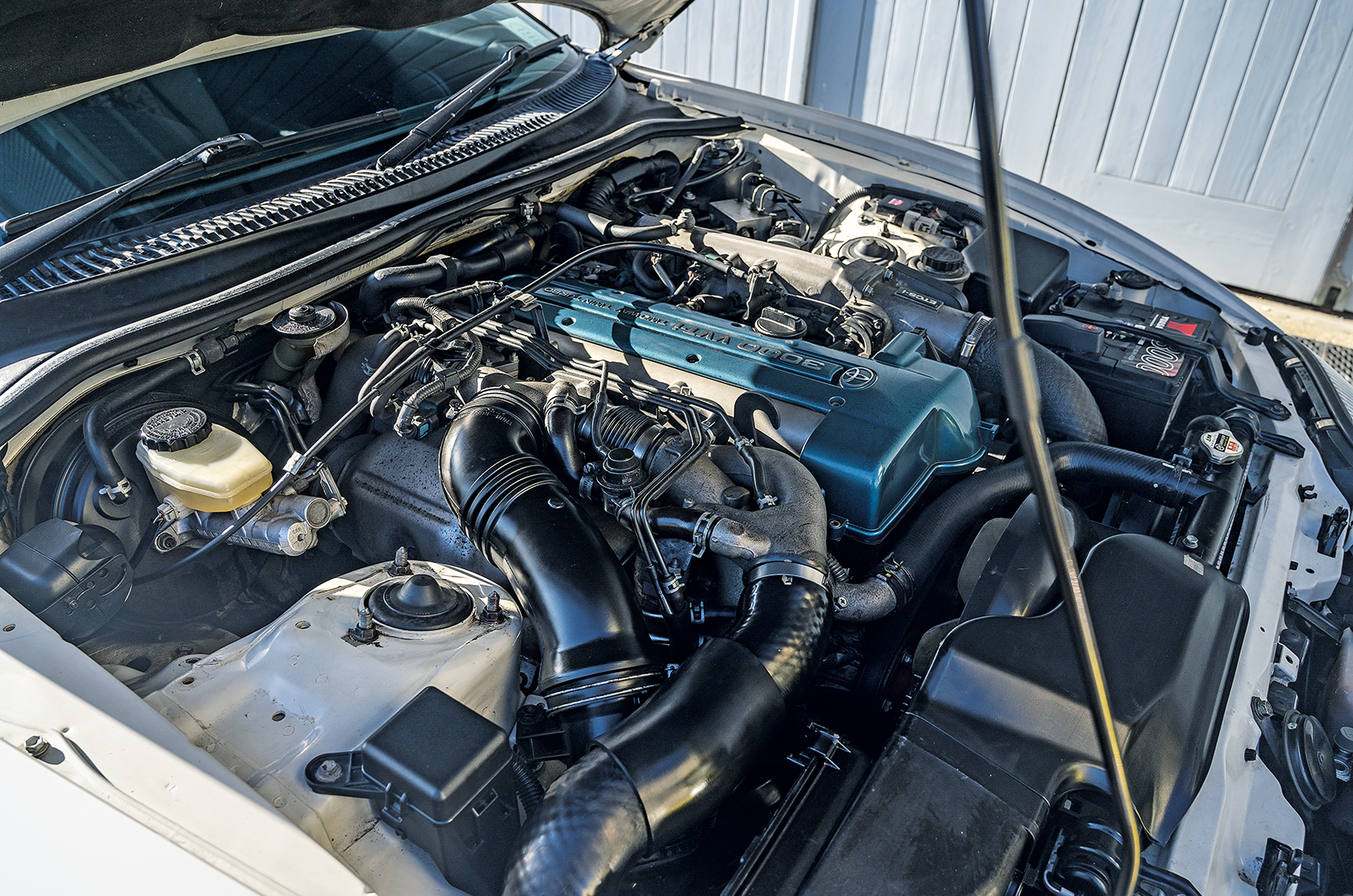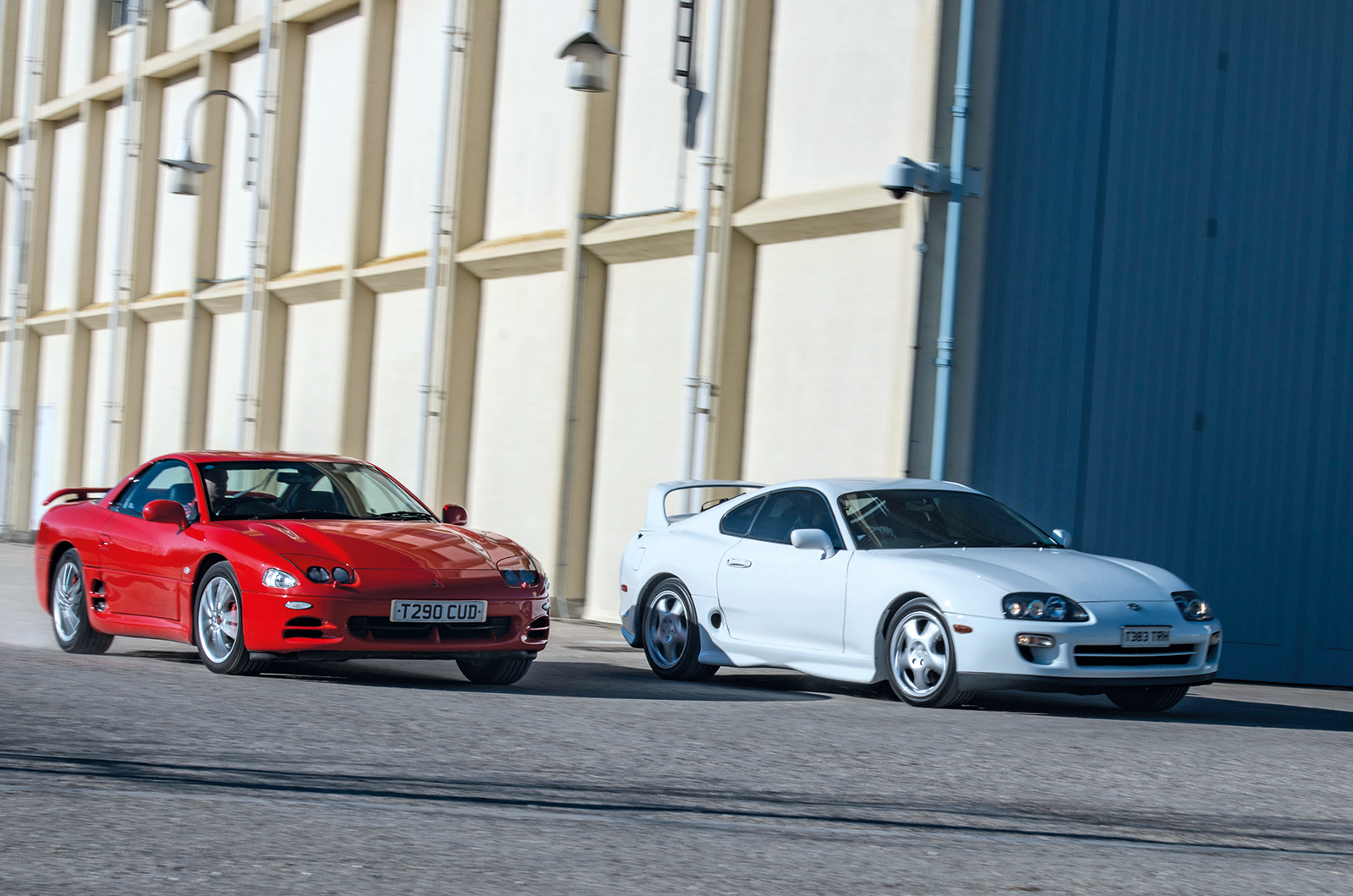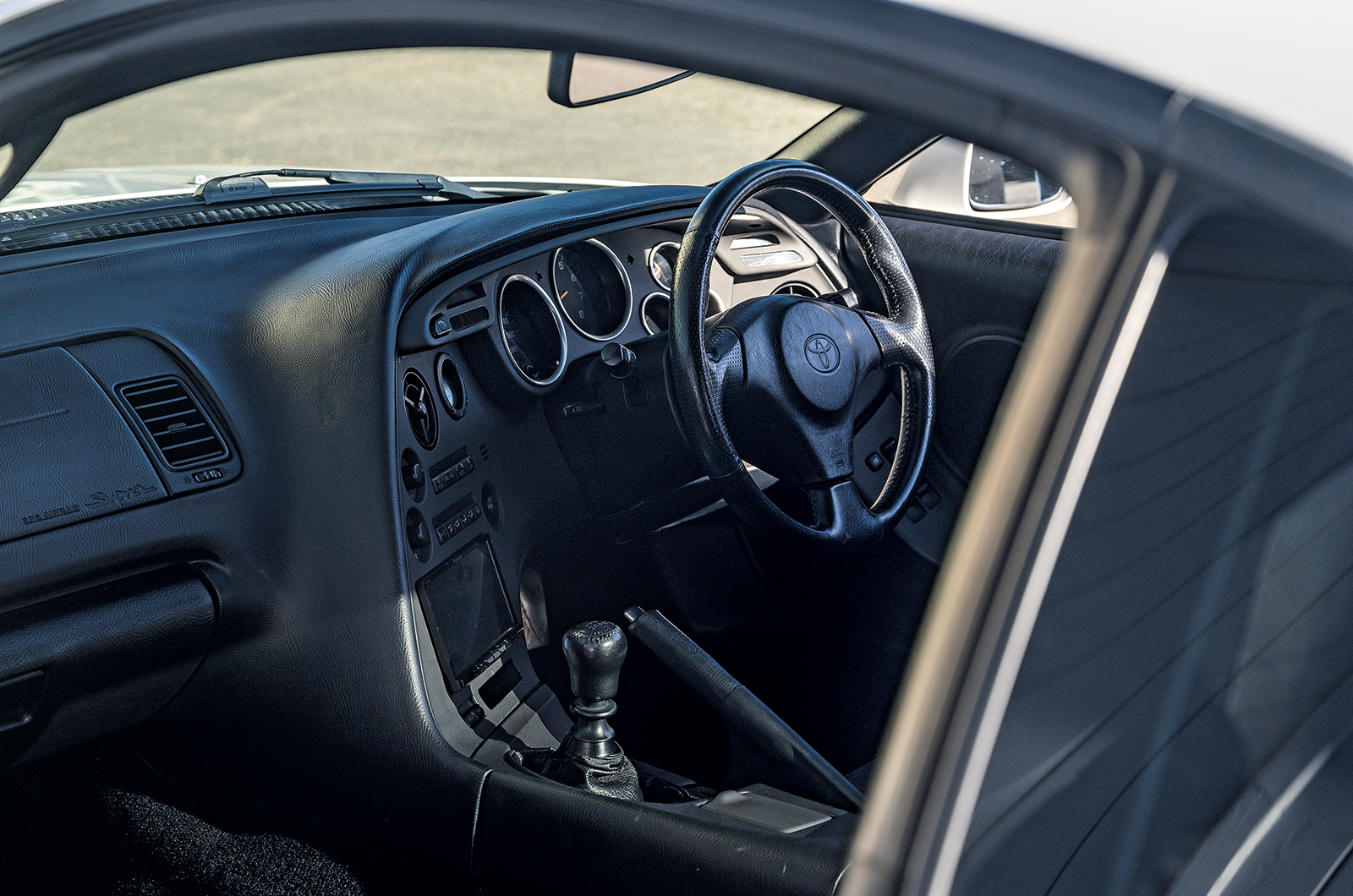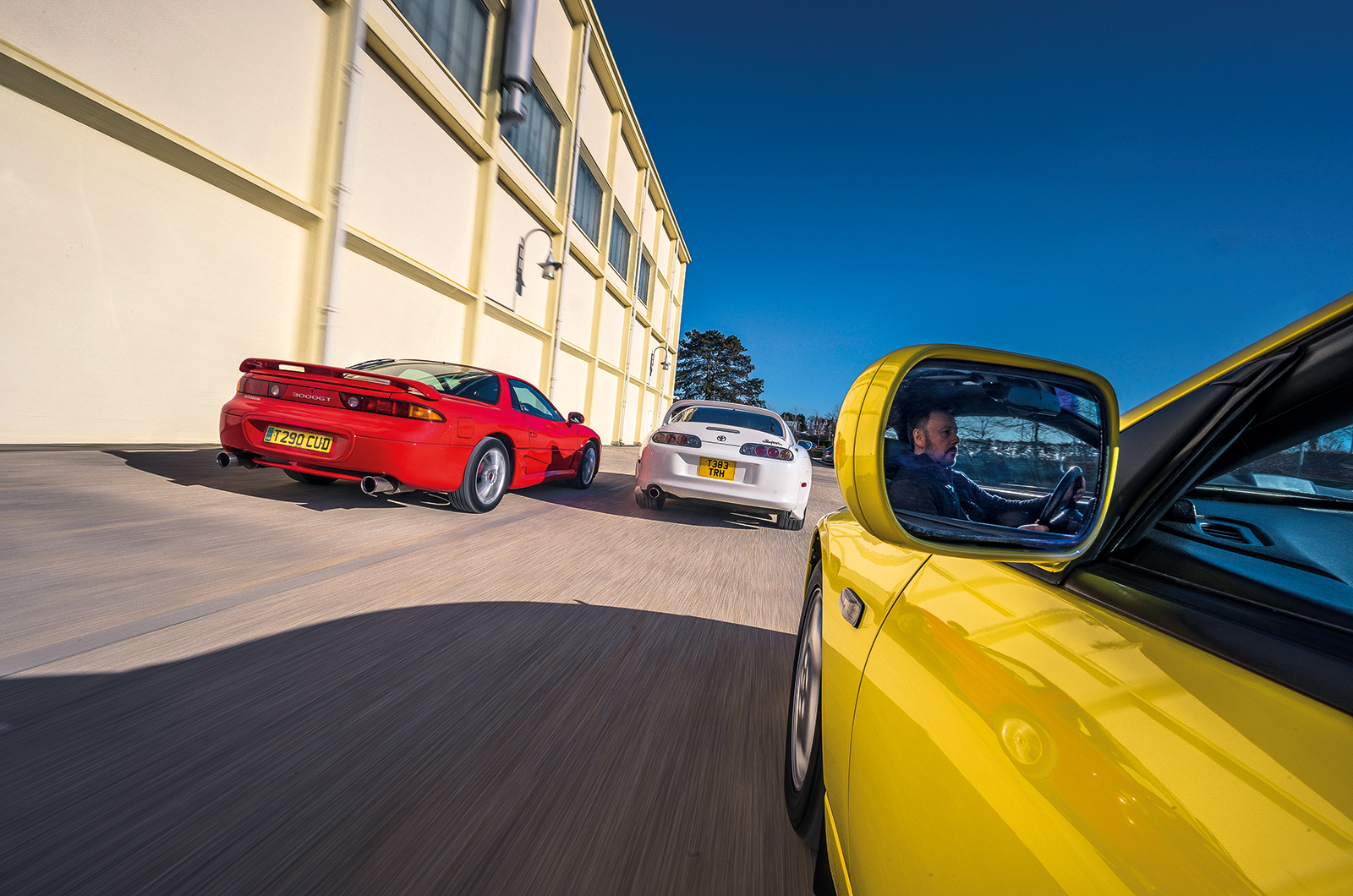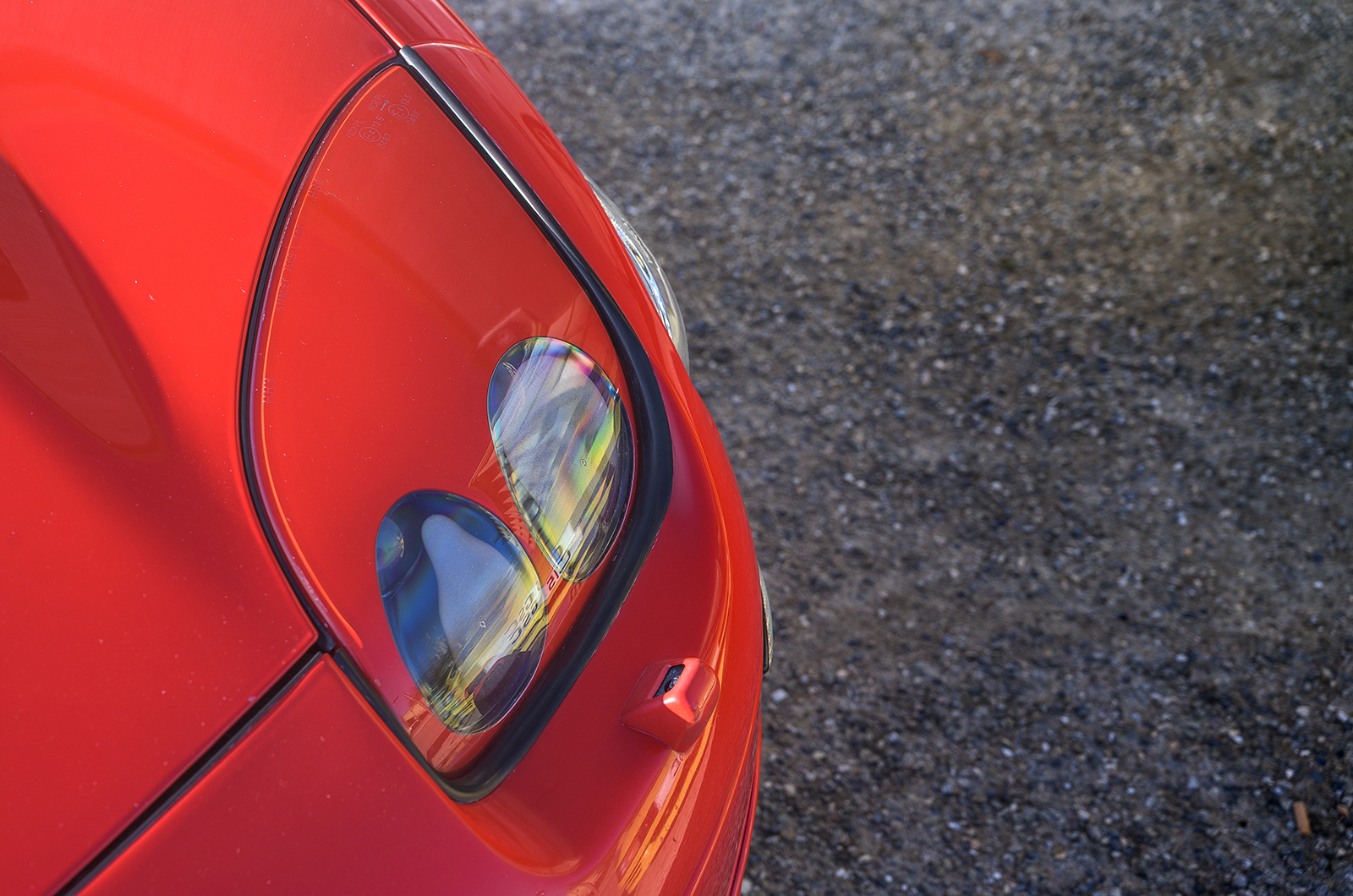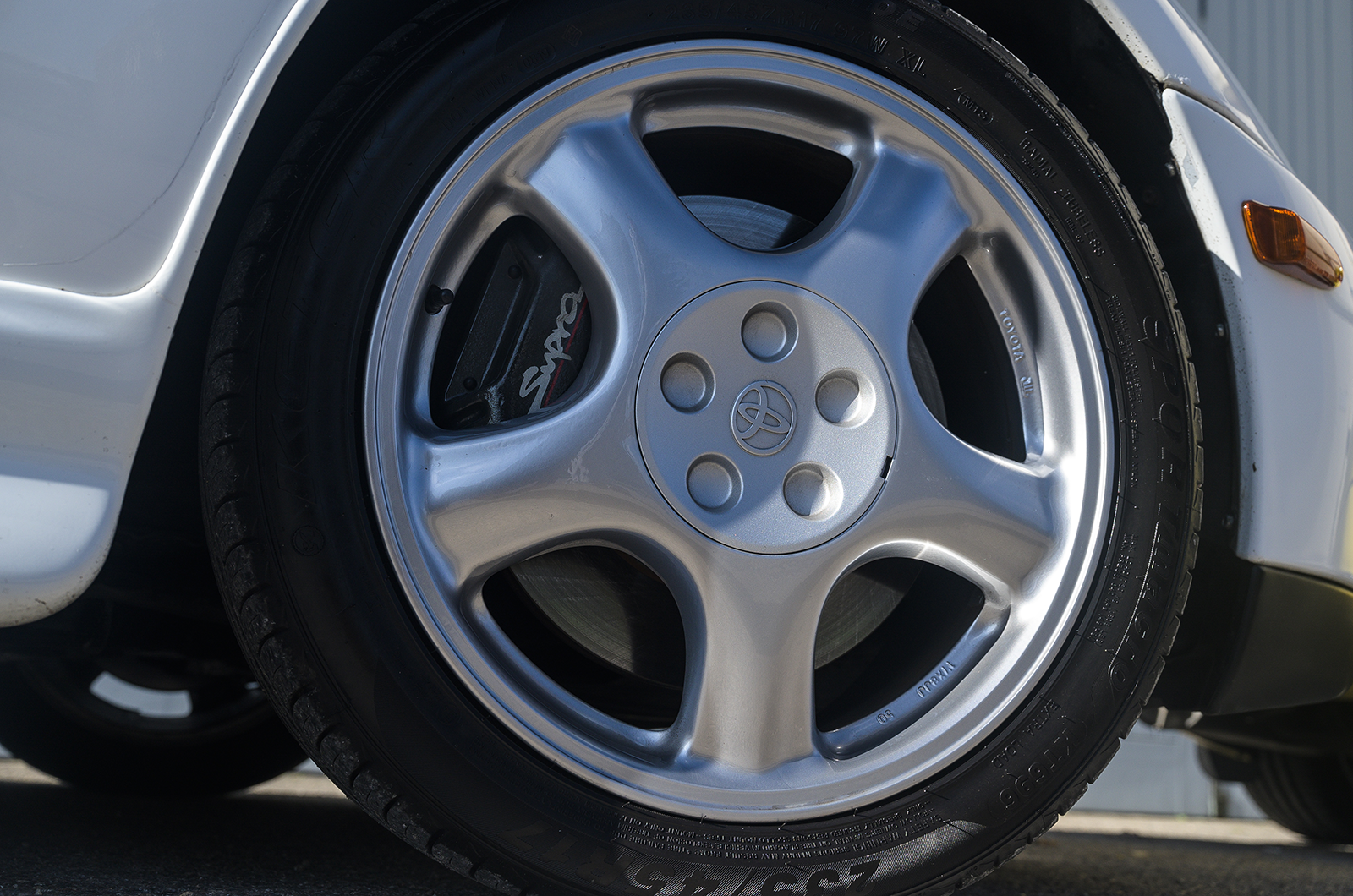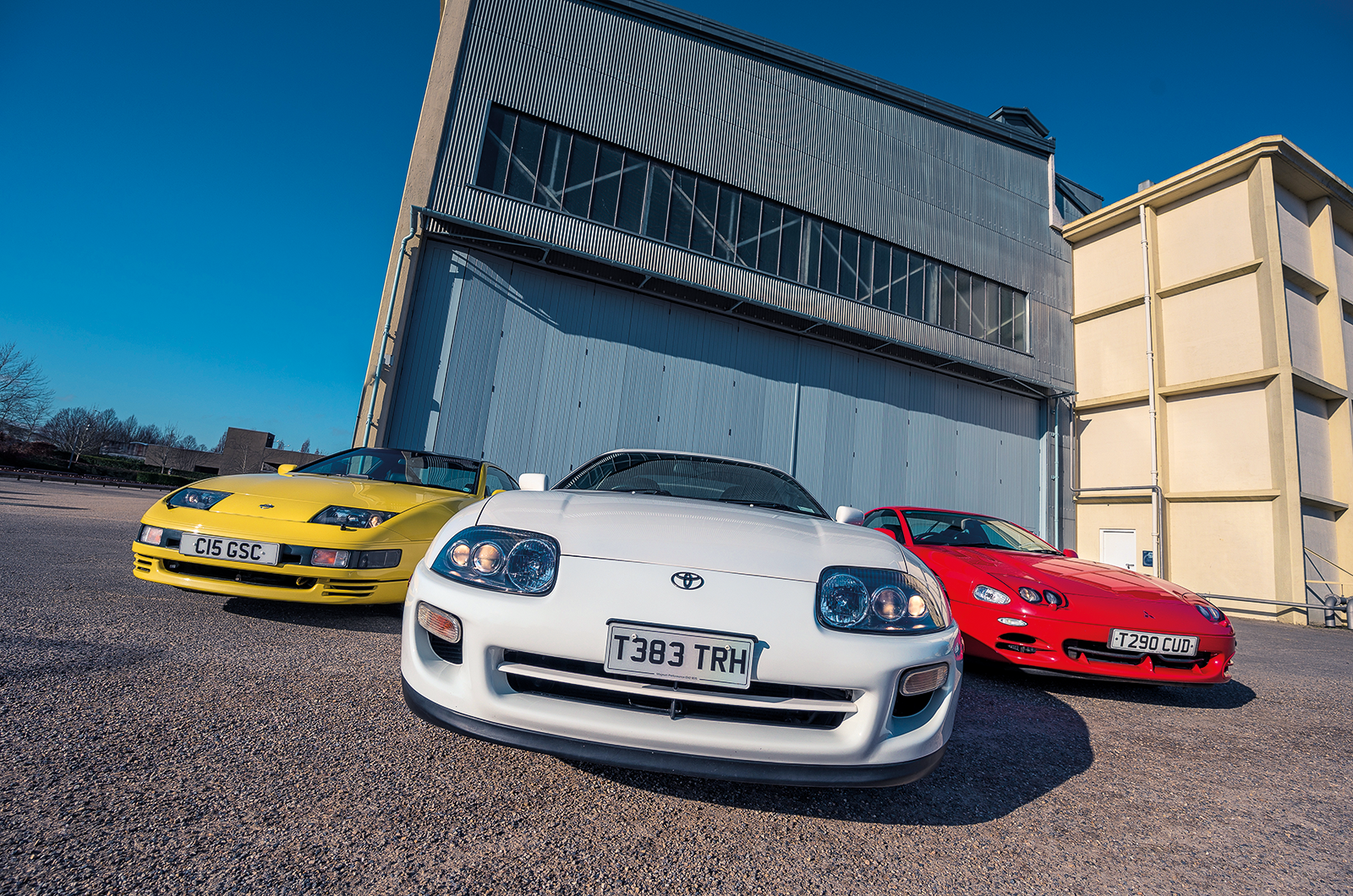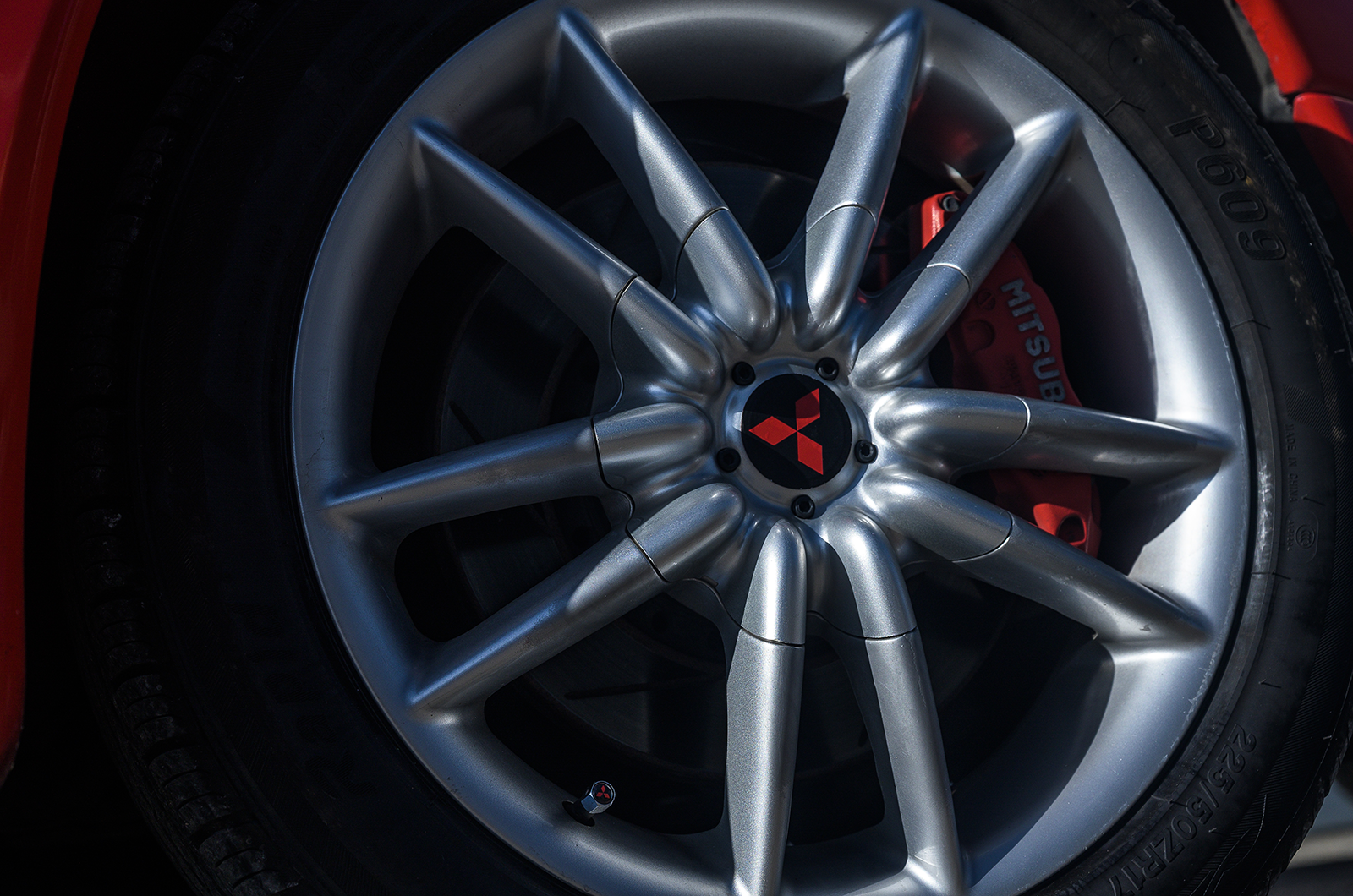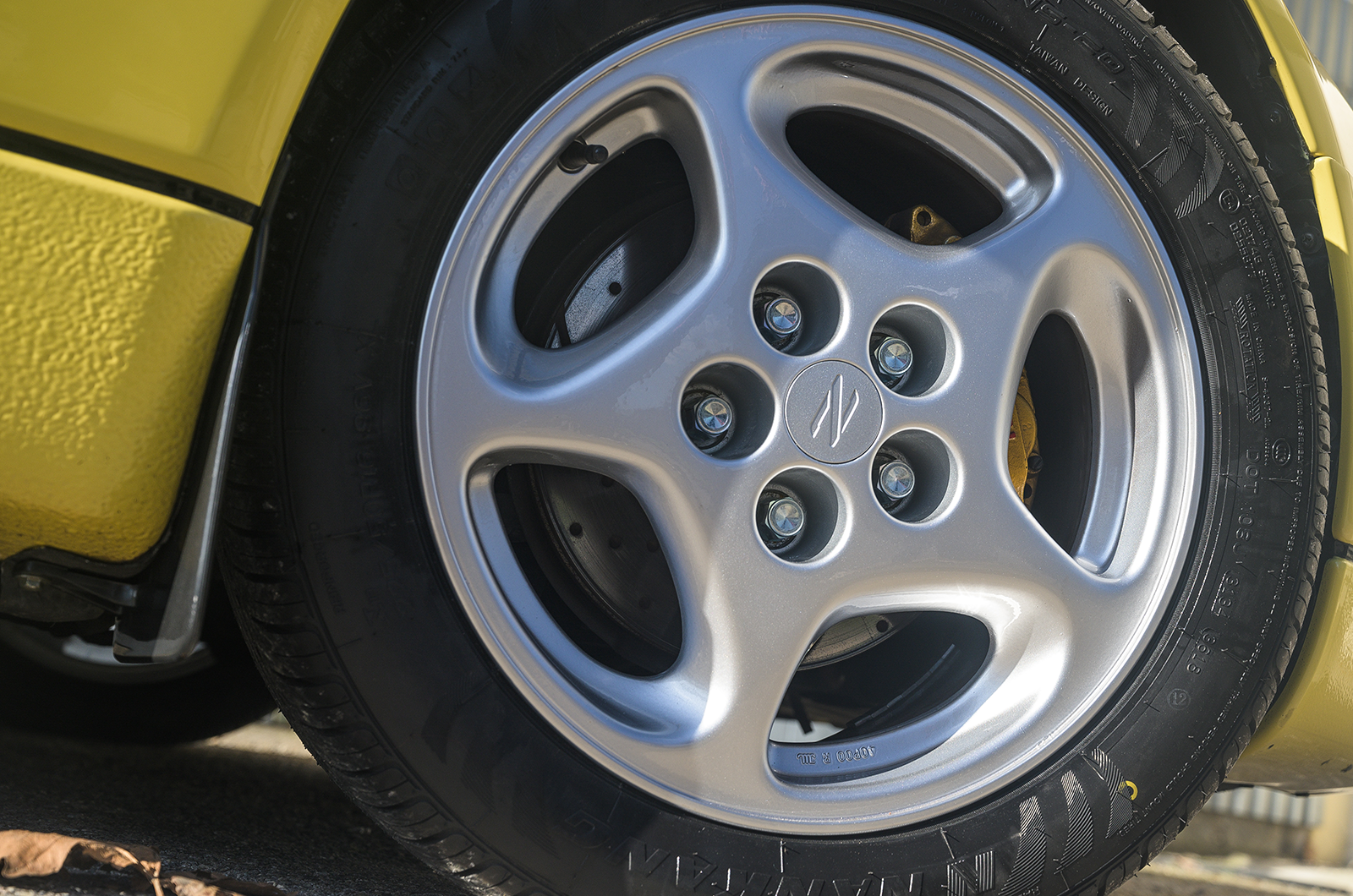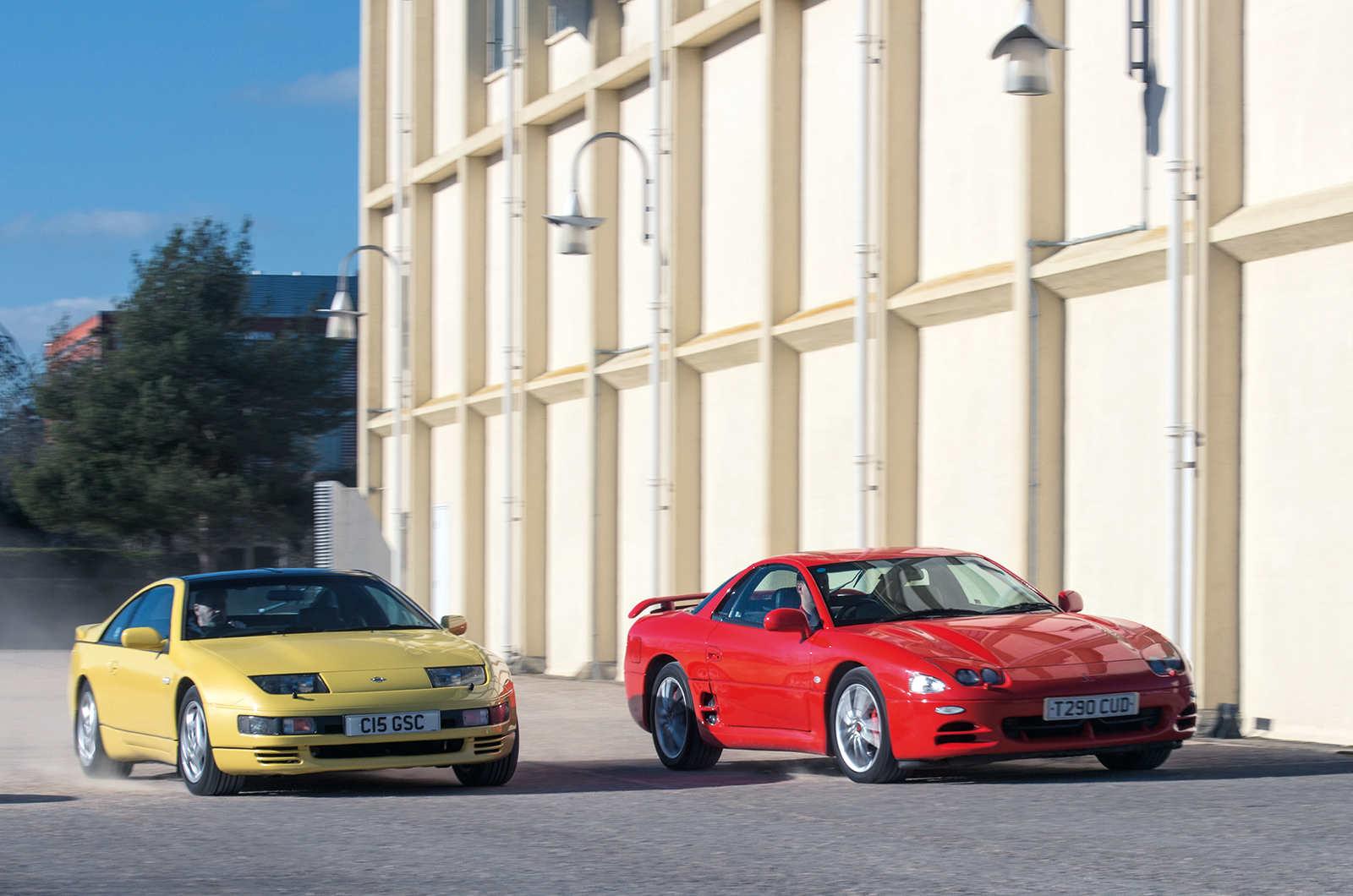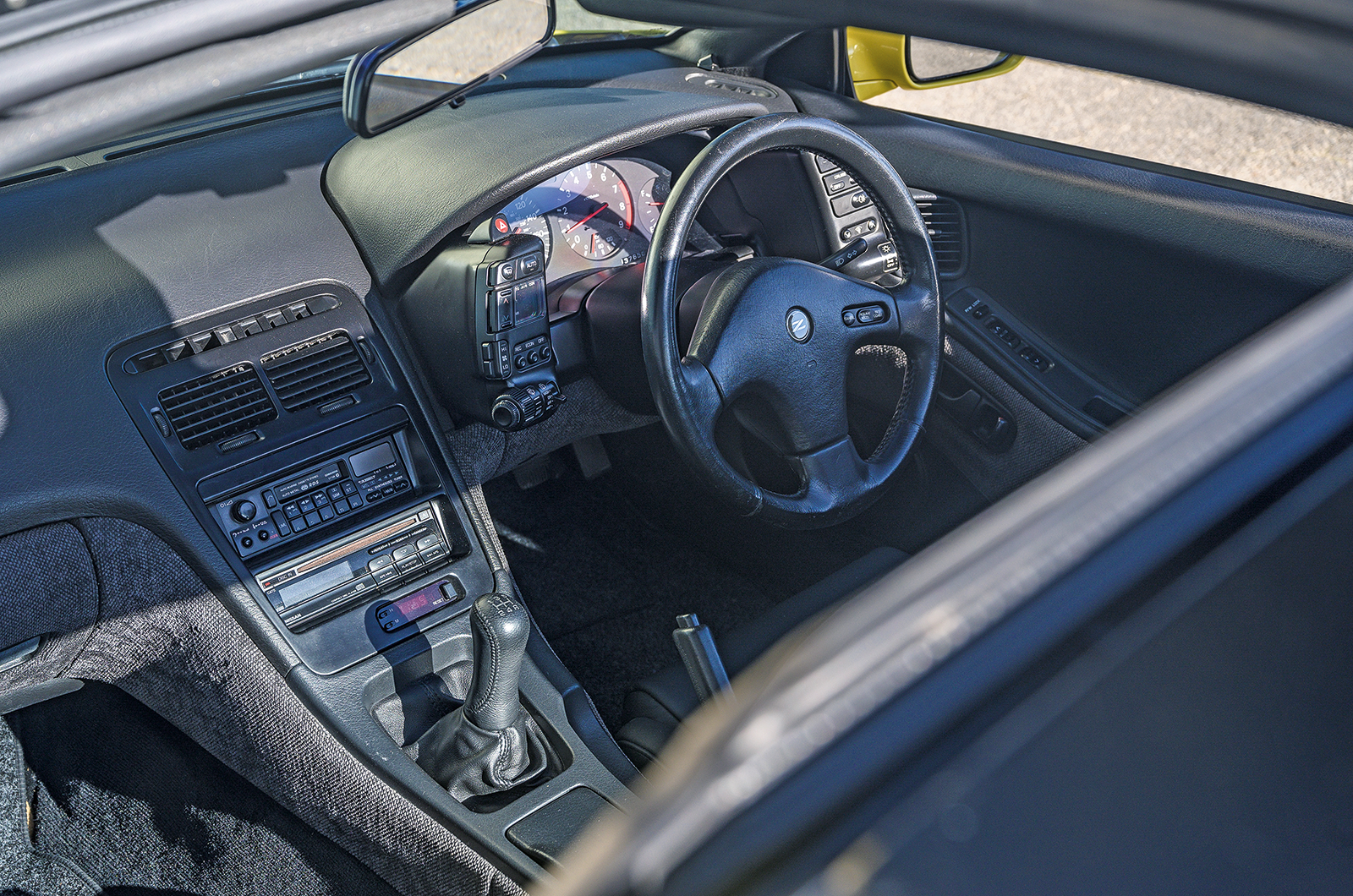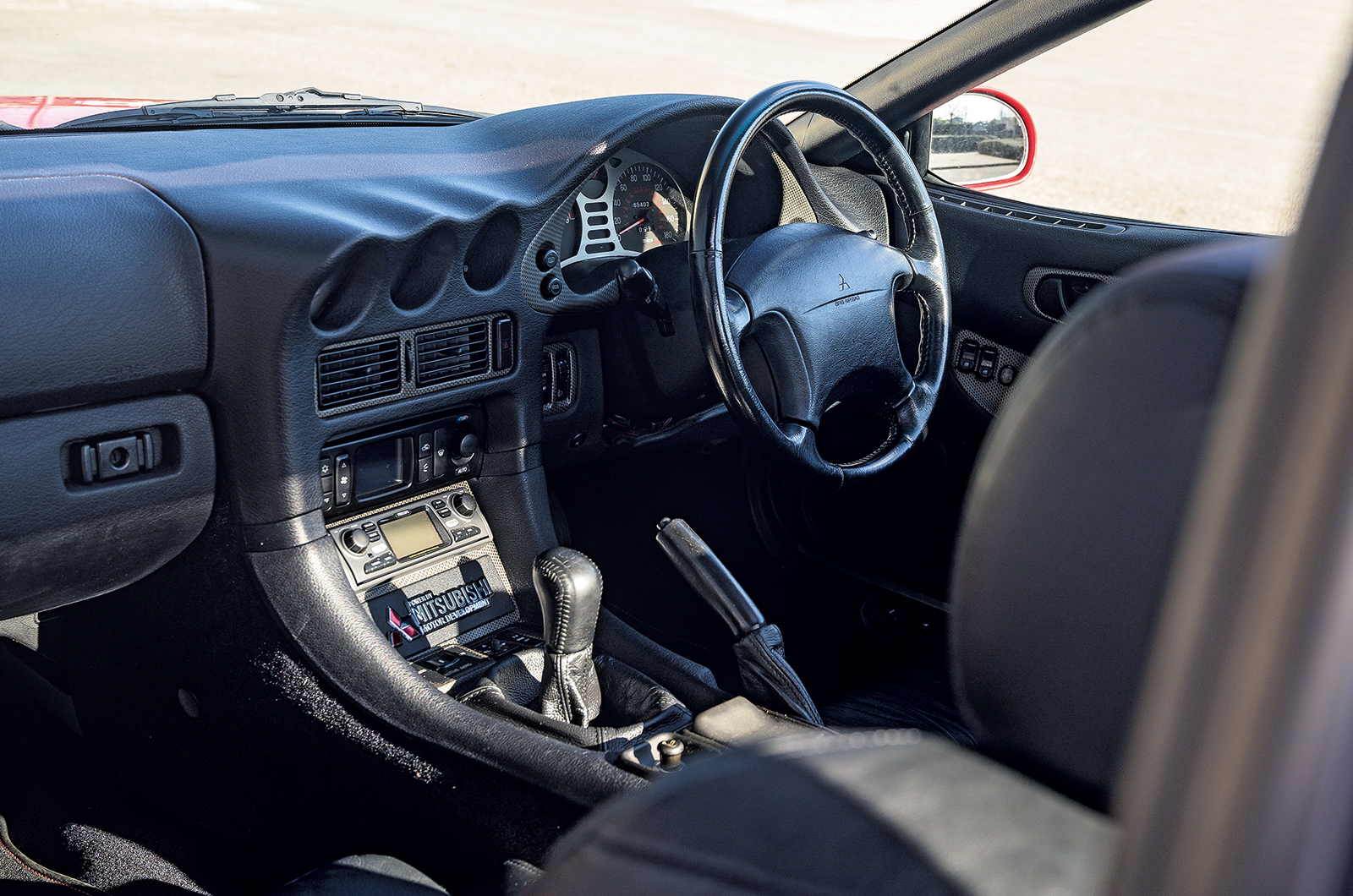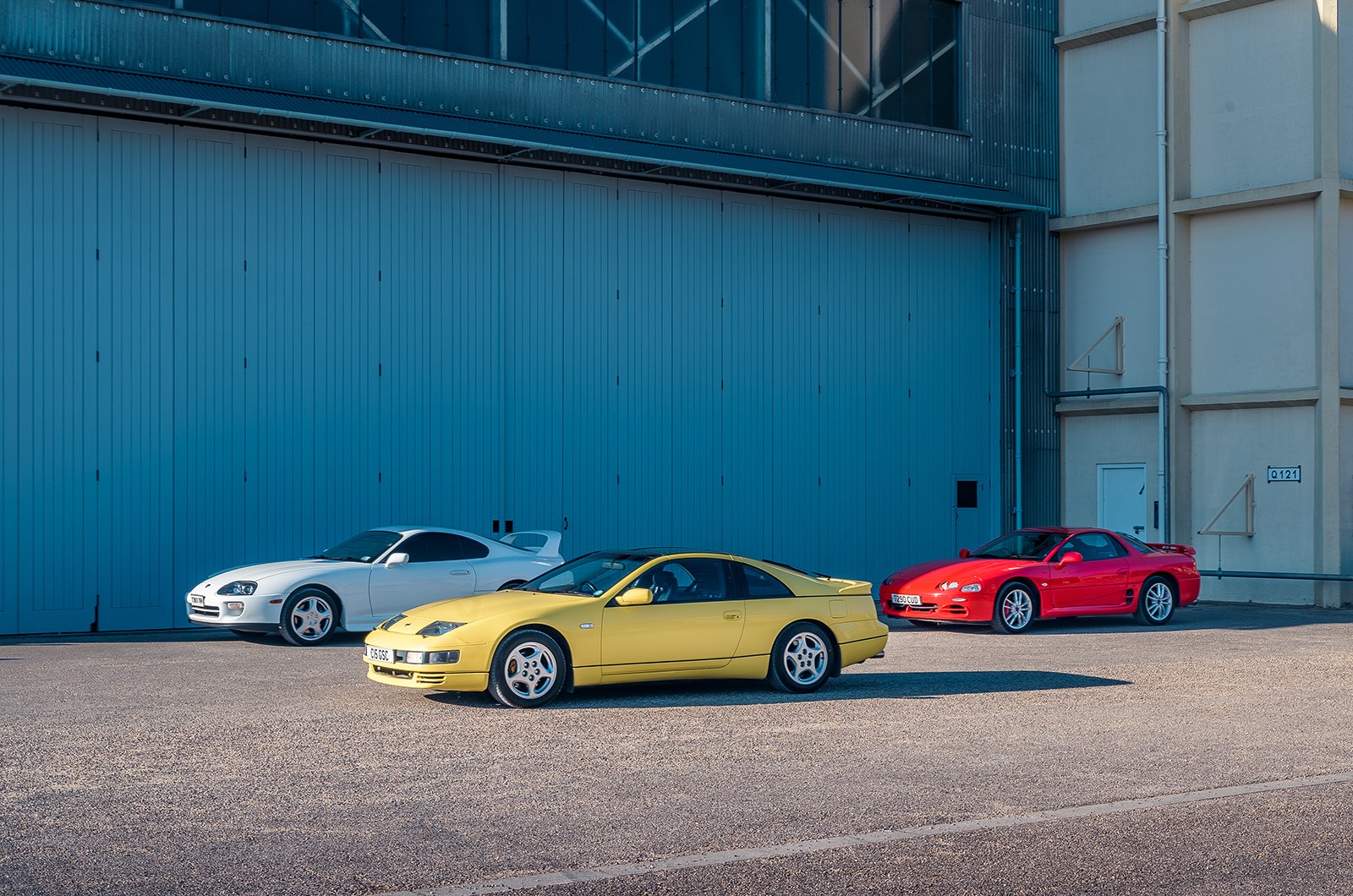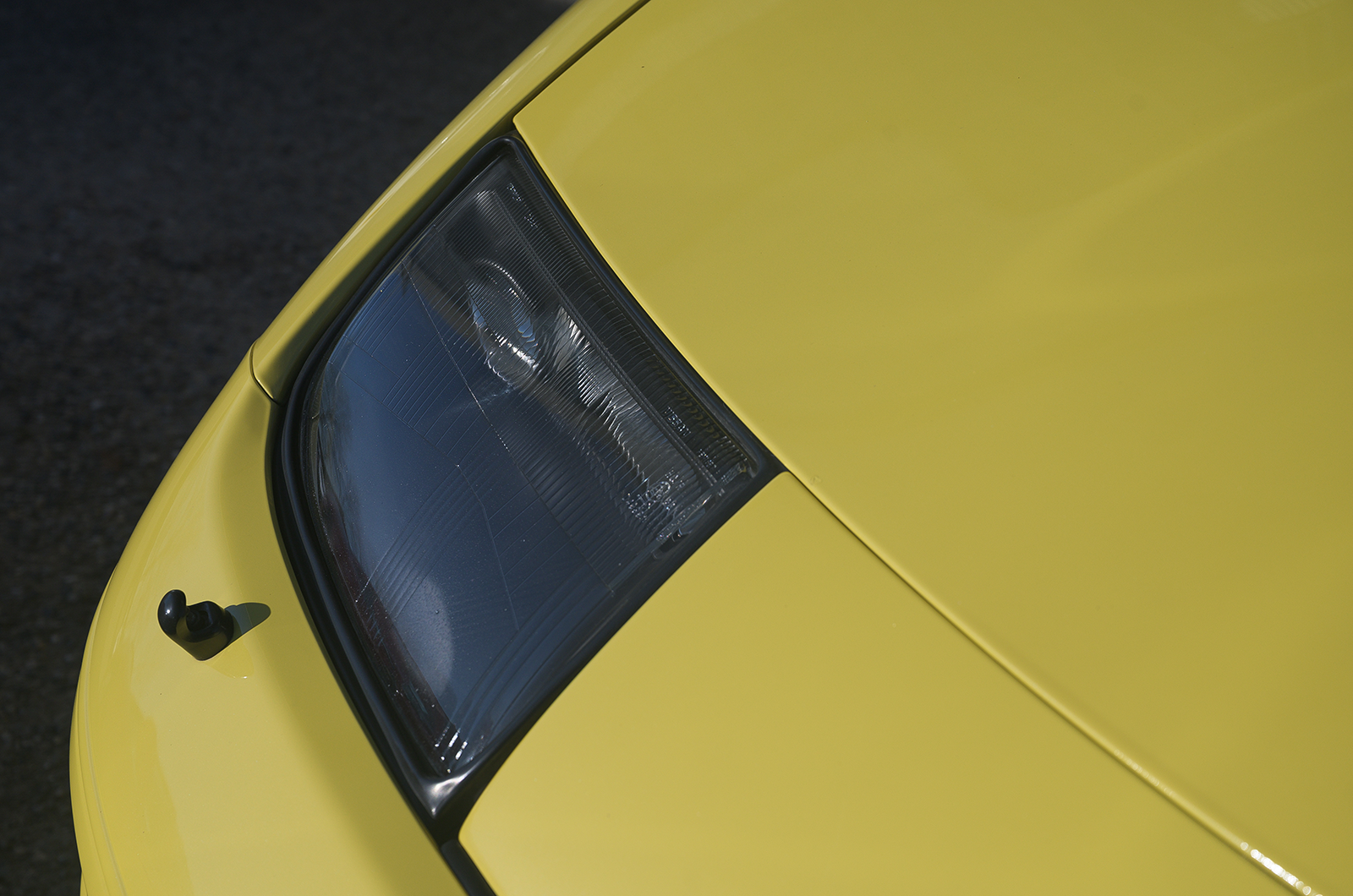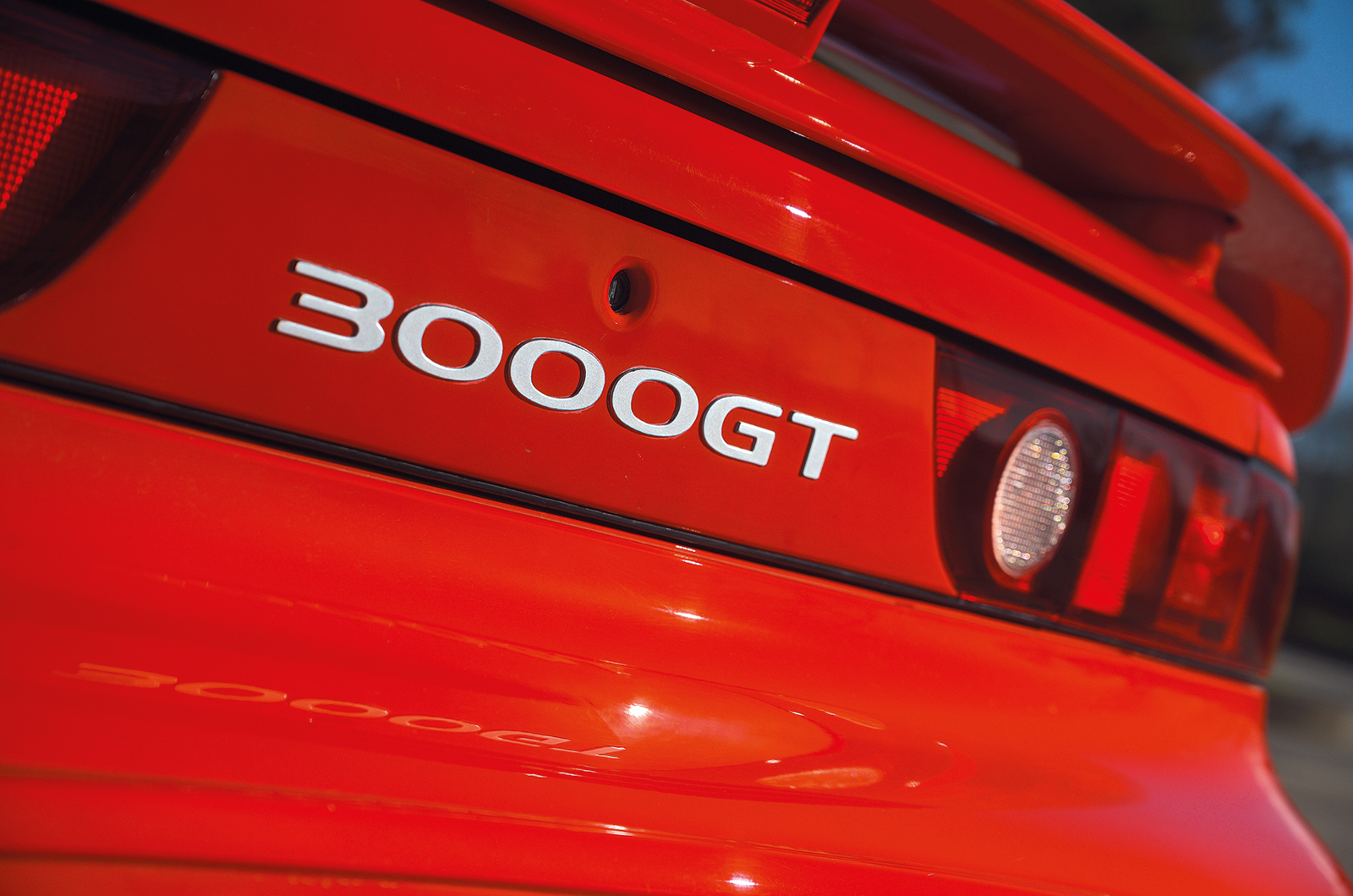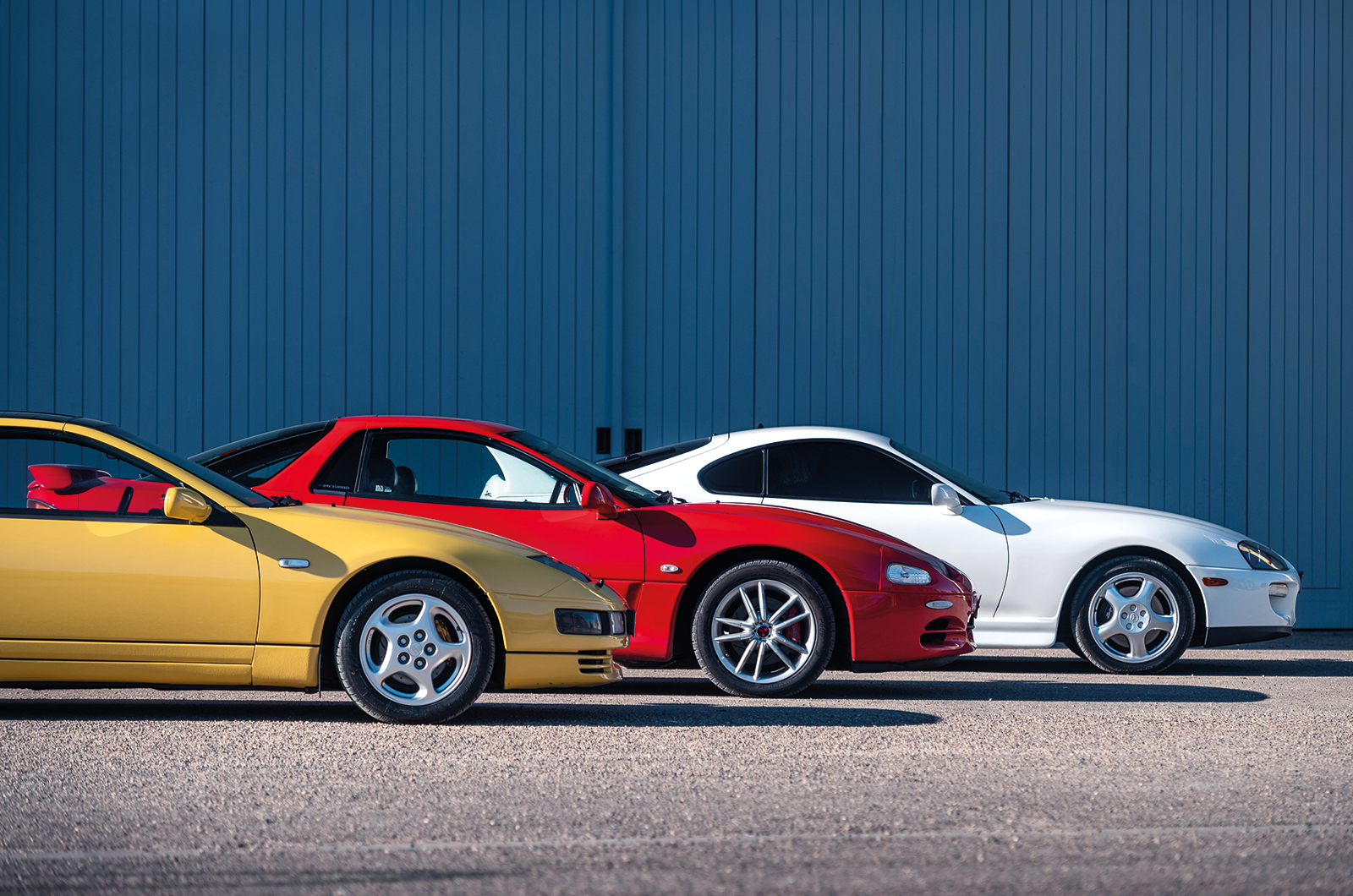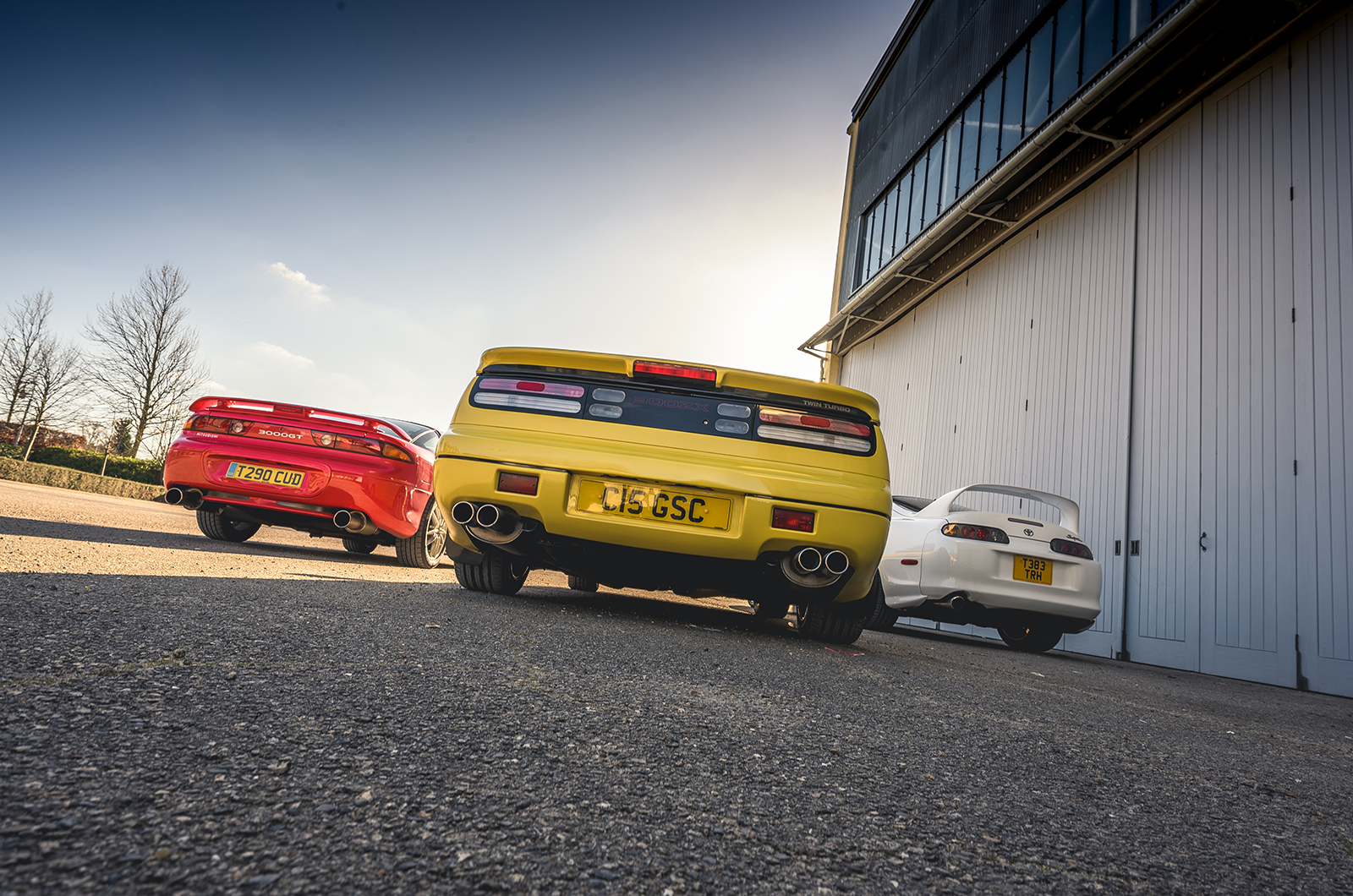But switching to the Supra and attacking the same bends reveals how much more eager the Toyota is to turn.
A ruthless diet that extended to the use of aluminium for the bonnet and front crossmember, a plastic fuel tank and even hollow carpet fibres meant the MkIV Supra weighed almost 100kg (220lb) less than the MkIII – and was a substantial 231kg (510lb) lighter than the Mitsubishi.
Plus, with a superior front:rear weight distribution (52:48, versus 57 up front for the GT) and with all of the engine’s torque sent to the back, rather than a nominal 55% courtesy of the Mitsubishi’s viscous centre diff, it instantly feels the more sports car-like.
Bewinged Toyota (centre) is the most curvaceous of our trio, while the Mitsubishi (right) and Nissan are more conventional wedges
The Toyota goads you to thrash it in a way the 3000GT doesn’t. It’s like hanging around with the naughty kid at school.
The one who’s always encouraging you to do something outrageous you know you shouldn’t, but do anyway, and then runs like crazy to evade a telling-off.
There’s not much you couldn’t evade from behind the wheel of a twin-turbo A80 in full flee mode. Domestic-market Supras made do with 276bhp to keep in line with the Japanese manufacturers’ gentleman’s agreement, though likely made more.
European cars did make more: 326bhp, thanks to different turbos and injectors, and, though Adam Hunter’s Japanese car claims to be standard, a dyno printout suggests that it is, shall we say, unusually fit.
Different styles for the Mitsubishi (left) and Nissan
Whatever it produces, it makes mincemeat of the other two in a straight line.
Stomp your foot from low revs and the 2JZ motor is fed initially only by one turbocharger, before the second chimes in to really test your neck muscles at around 4000rpm.
The noise isn’t a garrulous roar, but an eerie, turbine-like yowl. Or maybe that was just the sound of the other two crying in the distance.
Contemporary figures put the Supra at 5.1 secs to 60mph and around 13 to 100. Only electronic intervention at 155mph prevented it from sailing on to a true 180mph.
But the Supra doesn’t get it all right. The Getrag ’box is fairly long of throw and, though the changes are light, there’s a slightly knuckly feel to the way it moves through its gate.
Mitsubishi 3000GT leads Nissan 300ZX
The steering, too, is perhaps over-light in the first few degrees off the straight-ahead, which it probably needs to be if you’re to catch the monstrous slides the blinking traction-control light hints are coming your way if you decline its help via the button on the dashboard.
That lightness adds to the impression of agility, but it doesn’t deliver masses of information in the process. If it’s communication you’re after, a Porsche 968 or a Mazda RX-7 is a better bet.
So is the ZX. There’s something delightfully uncomplicated about the Nissan. It might not be quite as quick as the Supra, but with a similar 276bhp to the Mitsubishi, and the equivalent of two burly doormen less to haul around, it still hauls: Autocar recorded 5.6 secs to 60mph.
Gary Crowther’s rare ’91 Sahara Gold ZX (only 44 of 1525 UK cars were this colour) feels every bit as quick today, pushing you back into a seat that’s mounted a little higher than perhaps you’d like.
The T-top roof floods the 300ZX’s quirky cabin with light
But there’s more to the Z than straight-line speed and a stirring V6 soundtrack.
There’s the firm brake pedal, fine body control and the well-defined gearchange, which strikes a balance between slick and satisfyingly mechanical – and is the best here.
As is the steering, whose consistently meaty weighting gives you the confidence to lean on the nose on the way into a corner, then nibble at the rear-end grip on the way out.
Period testers complained of unruly wet-weather behaviour – something 3000GT drivers, who’d traded some delicacy for security, never had to worry about.
But in the dry it feels fun and exploitable, yet entirely manageable. Above all, though, despite packing a four-wheel steering system even more sophisticated than the 3000GT’s – in which the rear wheels are capable of pointing in the same direction as the fronts at high speed, but the opposite way in the tighter, slower stuff – it feels entirely natural.
An ugly airbag-equipped wheel fronts a moulded dash with retro cues in the 3000GT
Although they lived on in other markets, all three cars had disappeared from UK showrooms by the tail end of the ’90s, victims of emissions regulations and the waning popularity of big coupés.
The next Z was the 350Z, a simpler, cheaper two-seater, while the GT was usurped as Mitsubishi’s halo car in its own lifetime by the rally-winning Evo.
The only badge still around is Supra, recently resurrected after a 20-year layoff and affixed to a rebodied BMW Z4.
Though all cost similar money when new, prices have diverged markedly in the years since.
A powerful trio
The 3000GT is the cheapest of the bunch at around £5000 for a usable car and perhaps £10k for something great.
It’s the fussiest to look at but the least fussy to live with – a fascinating example of Japan’s thirst for technology, but one that didn’t quite serve up the thrills or pace of the other cars here, or Nissan’s conceptually similar Skyline GT-R.
Jones saves his for best, but with four-wheel drive, a roomy cabin and huge boot, plus a‘ Tour’ mode on the adaptive dampers and long gearing for intergalactic cruising, it’s the most suitable for everyday use or epic road trips, provided – as with the other two – you don’t expect to carry adults in the token rear seats.
It might not be a great sports car, but it makes a very fine GT. Accept that and you’ll like it far more than contemporary testers did.
Bright colours work well on these supercoupés
At up to four times the value, the Supra is a different proposition.
It feels stronger, more mischievous, more driver-focused, less practical. Its cult status certainly appeals but, at £30k-plus in desirable manual form, the price may not.
Which leaves the Zed. Heaped with praise when new, and criminally forgotten since, the 300ZX is a blast to drive with crisp steering, entertaining handling and a soulful V6.
And is it just us, or has that slightly bloated, barrel-chested styling come into its own of late?
In profile – but which would you choose today?
But here’s the clincher: summing up the Z in 1991, Autocar raved about the value proposition presented by a car it described as: ‘An old-fashioned, up-front bruiser that begs to be driven hard.’
Then, it cost the equivalent of a not-inconsiderable £75k; today, a really nice manual twin-turbo would set you back around £15k.
There aren’t many bargains left in the classic car world, but this is one.
Images: Olgun Kordal
Thanks to 300ZX Owners’ Club; MkIV Supra OC; GTOUK
Factfiles
Nissan 300ZX
- Sold/number built 1989-2000/164,170
- Construction steel monocoque
- Engine iron-block, alloy-heads, dohc-per-bank 2960cc V6, with twin turbochargers and electronic fuel injection
- Max power 276bhp @ 6400rpm
- Max torque 274lb ft @ 3600rpm
- Transmission five-speed manual, RWD
- Suspension independent, at front by double wishbones, anti-roll bar rear multiple links; coil springs, telescopic dampers f/r
- Steering power-assisted rack and pinion, four-wheel steering
- Brakes discs, with servo and anti-lock
- Length 14ft 10in (4525mm)
- Width 5ft 11in (1800mm)
- Height 4ft 1½in (1255mm)
- Wheelbase 8ft 5¼in (2570mm)
- Weight 3480lb (1579kg)
- 0-60mph 5.6 secs
- Top speed 155mph
- Mpg 17
- Price new £34,500
- Price now £15,000*
Mitsubishi 3000GT
- Sold/number built 1990-’99/86,151
- Construction steel monocoque
- Engine iron-block, alloy-heads, dohc-per-bank 2972cc V6, with twin turbochargers and electronic fuel injection
- Max power 282bhp @ 6000rpm
- Max torque 300lb ft @ 3000rpm
- Transmission five-speed manual (six-speed from 1996), 4WD
- Suspension independent, at front by MacPherson struts rear wishbones, trailing arms, telescopic dampers; coil springs, antiroll bar f/r
- Steering power-assisted rack and pinion, four-wheel steering
- Brakes discs, with servo and anti-lock
- Length 14ft 11½in (4560mm)
- Width 6ft (1840mm)
- Height 4ft 2½in (1285mm)
- Wheelbase 8ft 1¼in (2470mm)
- Weight 3990lb (1810kg)
- 0-60mph 5.8 secs
- Top speed 153mph
- Mpg 16.9
- Price new £35,500
- Price now £10,000*
Toyota Supra
- Sold/number built 1992-2002/45,230
- Construction steel monocoque
- Engine iron-block, alloy-head, dohc 2997cc straight-six, with twin turbochargers and electronic fuel injection
- Max power 326bhp @ 5600rpm
- Max torque 325lb ft @ 4800rpm
- Transmission six-speed manual, RWD
- Suspension independent, at front by double wishbones rear multiple links; coil springs, telescopic dampers, anti-roll bar f/r
- Steering power-assisted rack and pinion
- Brakes discs, with servo and anti-lock
- Length 14ft 9½in (4515mm)
- Width 5ft 11¼in (1811mm)
- Height 4ft 1¾in (1265mm)
- Wheelbase 8ft 4½in (2550mm)
- Weight 3415lb (1549kg)
- 0-60mph 5.1 secs
- Top speed 156mph
- Mpg 18.7
- Price new £37,500
- Price now £35,000*
*Prices correct at date of original publication
READ MORE
Datsun 240Z: Nissan’s new broom
The sky’s the limit: Nissan Skyline R32 meets 2000GT-R
America’s sweethearts: the ’60s GTs that took on the Sting Ray
Mazda MX-5 at 30: the great pretender
Chris Chilton
Chris Chilton is a contributor to Classic & Sports Car
